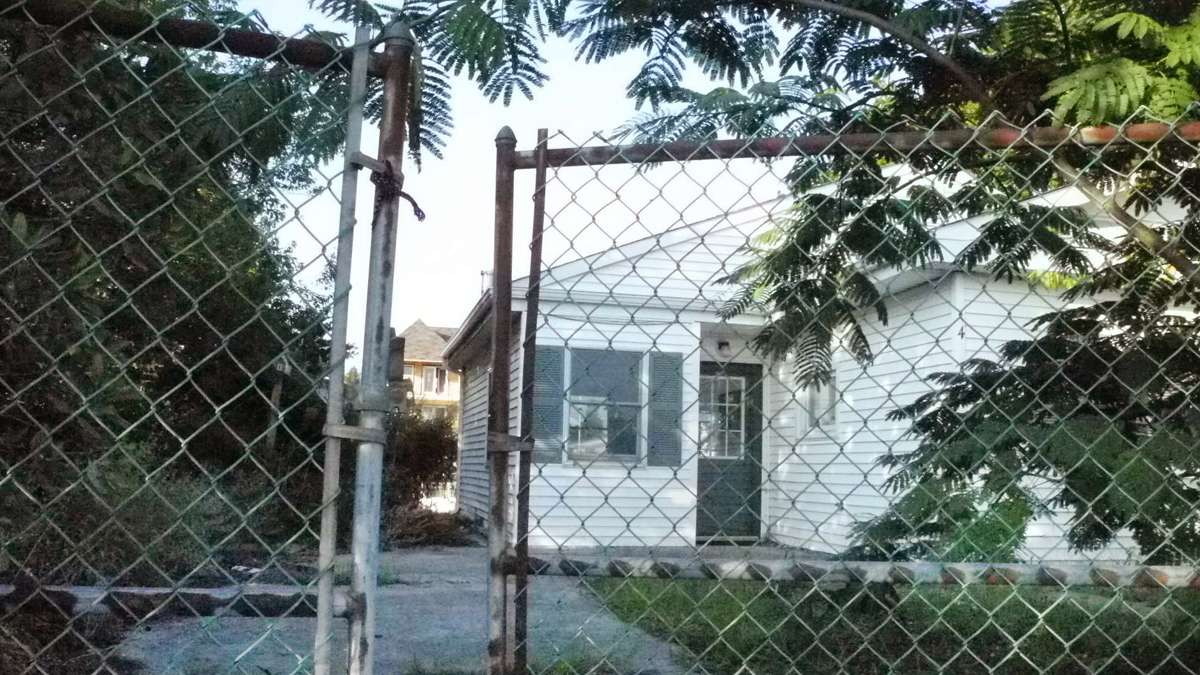Shore residents live among lingering Sandy damage
ListenAlexis Norton pushes through an unlocked gate in a chain-link fence just two doors down from her house in Little Egg Harbor, north of Atlantic City.
“This house here was abandoned,” she said, navigating overgrown bushes to make her way into the home’s backyard, where a broken dock dangles into a lagoon. “The mortgage company took their house. Apparently, they were late in their mortgage payments as it was.”
After the home flooded during Superstorm Sandy last October, representatives from the bank came to remove the water-logged furniture and repair the roof, but they didn’t strip the home of his drywall, wood paneling, or rugs.
“This is one house, this is one of many,” sighed Norton. She glanced toward the house next door; its overgrown yard, open windows, and a hole in the roof were visible from the street.
Of the roughly 30 homes on Norton’s dead-end street, only three have been fully repaired. Nearly one year after Superstorm Sandy smacked the Jersey Shore, some homes and businesses look like the storm never hit but others look like it came ashore just yesterday.
That means those who are able to return home often find themselves living in strangely empty neighborhoods, living among the skeletons of once beloved homes.
The frustration is rising
“We have the emails, phone calls, written complaints,” explained Mike Fromosky, the assistant administrator in Little Egg Harbor Township. He gestured to a three-inch stack of papers beside him. “This pile is actually complaints from this year.”
Fromosky said complaints from residents about the condition of nearby homes has more than doubled from last year. Town officials try to track down the home’s owners and learn about the status of repairs, but it’s often a long, difficult process.
“Most of the complaints are all the same,” he said. “The house is abandoned. No one’s done anything since Sandy. The grass is overgrown. There’s garbage in the yard.”
There were roughly 4,000 homes in Little Egg Harbor that sustained damaged during the storm. The township has reached out to homeowners, asking for information about houses that don’t seem to be making progress with repairs. Residents can file a complaint if they think a house isn’t living up to local codes or is unsafe.
Waiting for money
“People complain that we got all these abandoned houses. ‘You got to identify them,'” he said. “Well, how do you identify them? My house looked abandoned probably for nine months.”
It wasn’t. It’s just that rebuilding is slow, especially when homeowners are still battling with their insurance company or waiting to see what kind of money they might get through government grant programs. Both processes have been frustratingly difficult to navigate for homeowners. Many homes here are second homes, which don’t qualify for any state aid, and foreclosures pose additional problems.
“The context in New Jersey is that even aside from the hurricane, foreclosures have been rising,” said Daren Blomquist, a vice president with RealtyTrac, a company that monitors foreclosures across the country.
In many states, foreclosure rates are falling as the economy and housing market stabilizes, but foreclosures are still rising in New Jersey — up 67 percent so far this year over the same period last year.
In some cases, this may be due to Sandy. Recently, the Federal Housing Administration launched a loan modification program for some 600 homeowners facing foreclosures as a result of the storm.
However, Blomquist said most foreclosures in New Jersey aren’t storm-related.
“Most of it is due to this backlog of delayed foreclosures in New Jersey that was coming through anyway,” he said, noting that the foreclosure process is slower here than in other states.
The house next Lisa Stevens in Little Egg Harbor has been bank-owned for roughly four years now. It was in terrible condition before the storm, but Sandy made it worse.
“There was a lot of debris that came into that back yard,” said Stevens. “Definitely, the asbestos siding has spread more. We worry about, we don’t even know if some of it fell back into the water, or leached into the ground.”
Some of the neighbors recently dragged pieces of wood and other debris to the curb, sick of looking at it and hoping the town might haul it away.
Across the street, a home that was partially demolished before the storm causes further blight, a bathtub visible through its collapsed wooden frame.
Whether the homeowner is long gone or just waiting for more financial help to rebuild, these damaged houses are ever-present reminders of the storm. Some may pose health and safety threats. Town officials and homeowners alike want to speed the pace of repairs, to finally be able to put the storm behind them.
But try telling someone they need to work faster?
That’s tough too, said Little Egg Harbor’s Fromosky. He received an angry email from a resident recently that read, “Do you like harassing us?”
“We’re not harassing them,” he said. “As a victim of the storm myself, I know how long the process is. I know how hard it is.”
Fromosky said he understands that people are frustrated. But he said they also need to be patient – with the town, the state, and most of all, with their neighbors.
WHYY is your source for fact-based, in-depth journalism and information. As a nonprofit organization, we rely on financial support from readers like you. Please give today.






